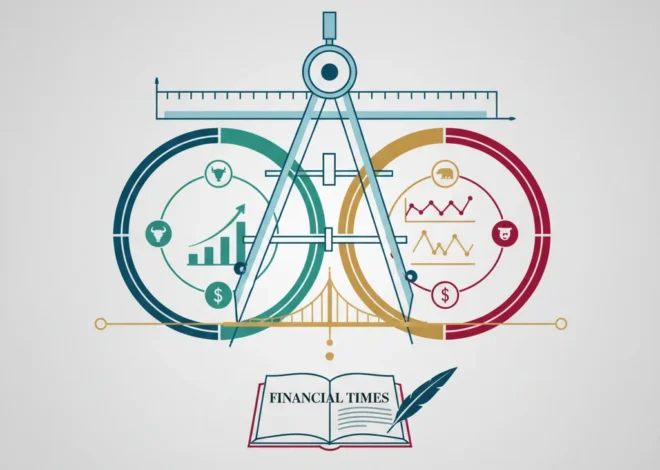
The Tomahawk Doctrine: How a Trump-Zelenskyy Summit Could Trigger a Seismic Shift in Global Finance
In the high-stakes theater of global politics, a single meeting can recalibrate the world’s economic and military trajectory. The announcement of a potential meeting in Washington between former President Donald Trump and Ukrainian President Volodymyr Zelenskyy is precisely such an event. According to reports, this summit is not just a diplomatic formality; it’s the stage for a potentially radical shift in U.S. policy, centered on a proposal to sell, not simply provide, advanced long-range Tomahawk missiles to Ukraine (source).
For investors, business leaders, and financial professionals, this development transcends headlines about military hardware. It signals a potential move towards a more transactional foreign policy, one that could reshape everything from the defense industry’s stock market performance to the intricate web of global finance and the future of the international economy. This isn’t just about ending a war; it’s about redefining the economic terms of engagement for global conflicts. Let’s dissect the multifaceted implications of this “Tomahawk Doctrine” and what it could mean for your investment portfolio and business strategy.
The Geopolitical Chessboard: More Than Just Missiles
To grasp the financial significance of this meeting, one must first understand the strategic weight of the proposal. The war in Ukraine has, for over two years, been a grueling conflict heavily reliant on a steady stream of Western aid. The current U.S. administration’s approach has been characterized by aid packages and the provision of increasingly sophisticated weaponry, a strategy that has propped up Ukraine’s defense but also created significant financial commitments for the U.S. and its allies. According to the Council on Foreign Relations, the U.S. has committed over $75 billion in assistance to Ukraine since the war began.
The introduction of Tomahawk missiles represents a significant military escalation. These are long-range, precision-guided cruise missiles capable of striking high-value targets deep within enemy territory. Their presence could dramatically alter the battlefield dynamics. However, the true paradigm shift lies in the proposed commercial nature of the transaction. The idea of “selling” such critical assets, possibly structured as a long-term loan, moves the conversation from one of aid to one of investment and debt. This re-frames the U.S.-Ukraine relationship and sets a new precedent for how America may engage with its allies in future conflicts, impacting long-term economics and national finance strategies.
Analyzing the Economic Ripple Effects
A fundamental change in the world’s most significant military and financial supporter of Ukraine will inevitably send shockwaves through the global economy. The implications stretch far beyond the immediate defense sector, touching everything from energy trading to the stability of the international banking system.
1. The Defense Stock Market Surge
The most immediate and obvious impact will be on the stock market, specifically within the defense and aerospace sector. A policy that involves selling high-value military assets like Tomahawks, manufactured by companies like Raytheon (RTX), creates a direct and sustainable revenue stream. This is a different financial model than government aid packages, which can be politically contentious and subject to budgetary battles. For investors, this signals a potential shift from speculative, event-driven trading in defense stocks to a more predictable, long-term growth outlook based on secured contracts. This could bolster valuations for a host of companies involved in the missile technology supply chain.
Below is a breakdown of the potential impacts on key market sectors stemming from this proposed strategic shift.
| Market Sector | Potential Upside | Potential Downside/Risks |
|---|---|---|
| Defense & Aerospace | Increased revenue from direct sales of high-margin hardware; long-term contracts could stabilize stock performance. | Geopolitical escalation could introduce volatility; dependence on a single conflict’s policy. |
| Energy (Oil & Gas) | Potential for de-escalation could lower prices and ease inflationary pressures on the global economy. | A dramatic escalation from new missile capabilities could spike prices, disrupting markets and supply chains. |
| Cybersecurity | Heightened conflict, even if transactional, will increase the risk of state-sponsored cyber-attacks on financial and critical infrastructure. | Increased costs for businesses to shore up defenses; market uncertainty. |
| Financial Services & Banking | New opportunities in structuring and financing sovereign military loans; growth in trade finance. | Increased exposure to sovereign debt risk; complexities in enforcing sanctions and navigating the global banking system. |
2. Repercussions for Energy and Commodity Trading
The war has been a primary driver of volatility in global energy and commodity markets. Russia’s position as a major oil and gas exporter and Ukraine’s role as a “breadbasket” for grain means any significant change in the conflict’s trajectory affects the global economy. The introduction of long-range missiles could lead to two divergent outcomes. On one hand, it could be perceived as a tool to force a quicker resolution, potentially stabilizing energy prices and easing food supply concerns. On the other, it could provoke a severe Russian response, targeting energy infrastructure and further disrupting the flow of goods, sending commodity prices soaring and complicating global trading.
A New Era of Financialized Foreign Policy?
The concept of selling, rather than giving, military aid introduces a new layer of financial complexity to international relations. This approach could involve sophisticated financial instruments, potentially managed by international banking consortiums or even backed by future Ukrainian assets. This is where financial technology, or fintech, could play an unprecedented role in geopolitics.
Imagine a scenario where military aid is structured like a sovereign bond, with repayment terms tied to the country’s future economic output. Such a model could, in theory, make aid more palatable to fiscally conservative factions, but it also places a heavy debt burden on a nation struggling to rebuild its economy. The IMF has already approved a $15.6 billion loan package for Ukraine, and adding military debt on top of that would create immense long-term pressure on its national finances. This could create new opportunities for those involved in sovereign debt trading and restructuring, but it also poses significant risks to Ukraine’s long-term economic stability.
This model could even, in a more speculative future, involve technologies like blockchain for ensuring transparency and tracking the deployment of assets tied to these financial agreements, merging the worlds of high-tech defense and high-tech finance.
Actionable Insights for Investors and Business Leaders
Navigating this complex environment requires a nuanced strategy. The outcome of this potential meeting is far from certain, but the themes it raises are here to stay. Here’s how to think about the implications:
- Re-evaluate the Defense Sector: Look beyond the immediate stock market bump. Analyze which companies are best positioned for a shift towards long-term, contract-based sales versus those reliant on fluctuating government aid budgets.
- Hedge Against Commodity Volatility: The energy and agriculture markets will remain sensitive to any news of escalation or de-escalation. Diversification and strategic hedging are more critical than ever for anyone with exposure to these sectors.
- Monitor Sovereign Debt Markets: The idea of “military loans” could create a new asset class within sovereign debt. Keep an eye on the credit risk of nations involved in prolonged conflicts and the financial instruments being developed to fund them. This is a critical area of macroeconomics to watch.
- Focus on Second-Order Effects: The most significant opportunities and risks may not be in the obvious places. Consider the impact on the insurance industry (geopolitical risk insurance), infrastructure and construction companies (post-war rebuilding), and cybersecurity firms tasked with protecting the increasingly digital sinews of war and finance.
The potential Trump-Zelenskyy meeting is a powerful reminder that geopolitics and global finance are inextricably linked. The proposal to sell Tomahawk missiles is more than a military strategy; it’s a financial doctrine with the power to alter investment landscapes, redefine international banking norms, and shape the global economy for years to come. For the prepared investor and business leader, understanding these deep-seated connections is the key to navigating the turbulent waters ahead.


